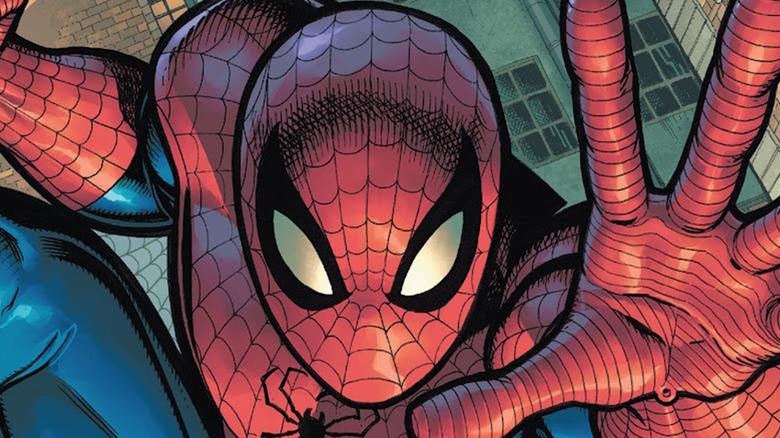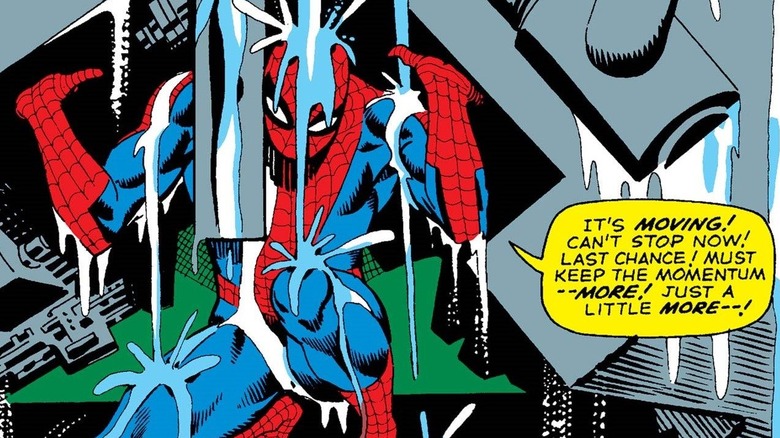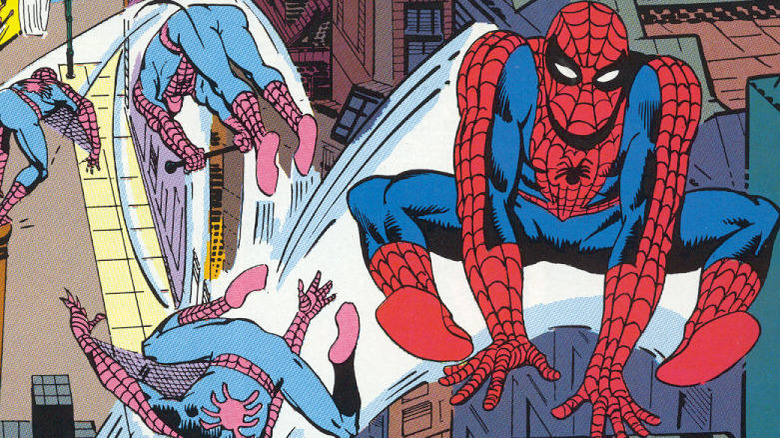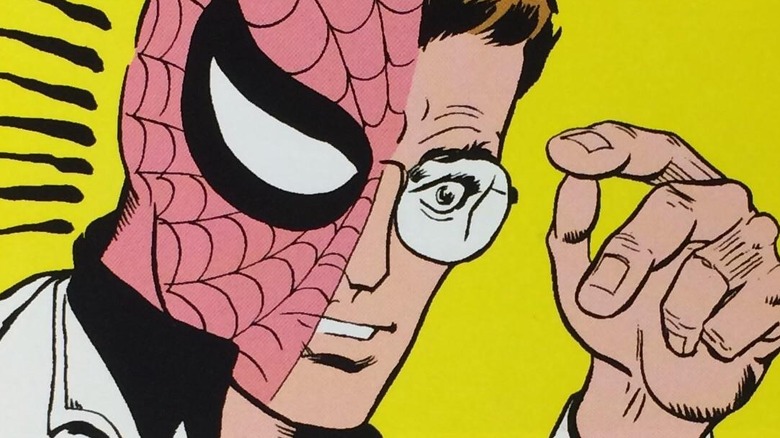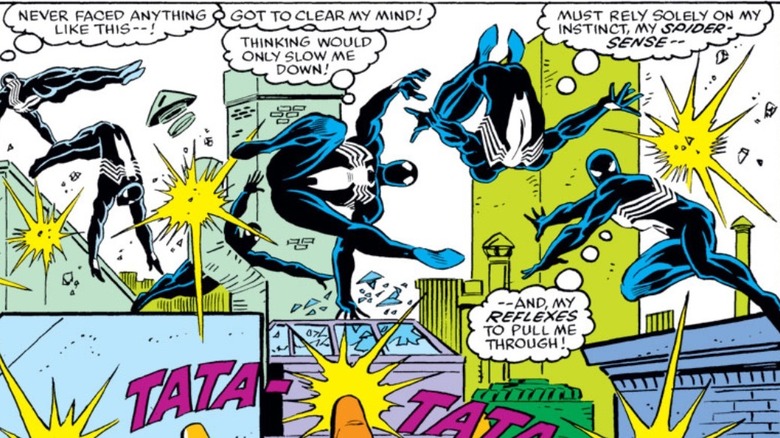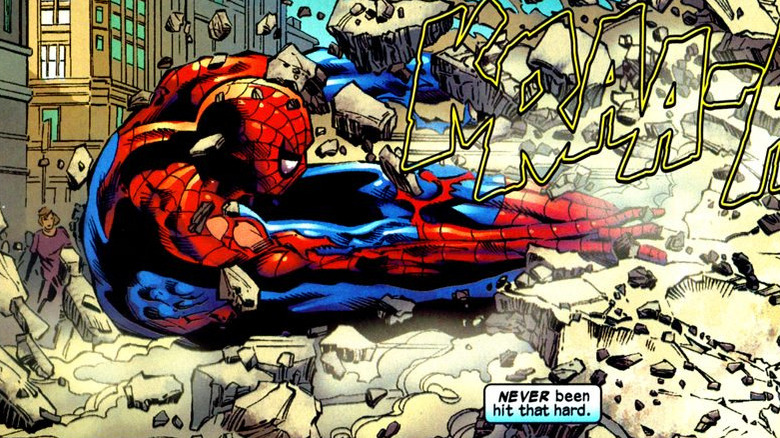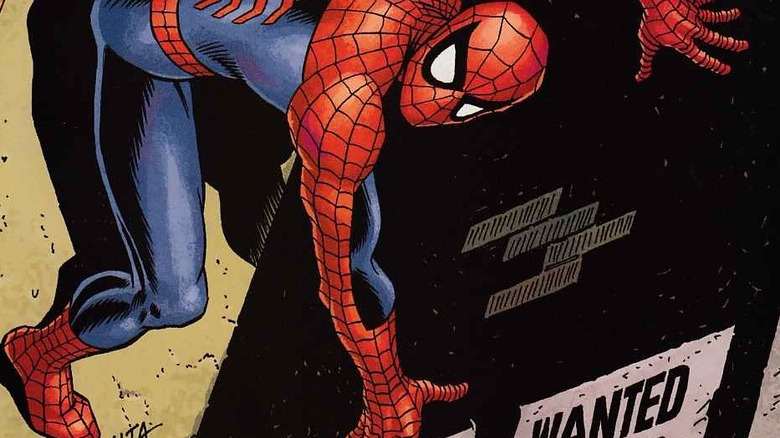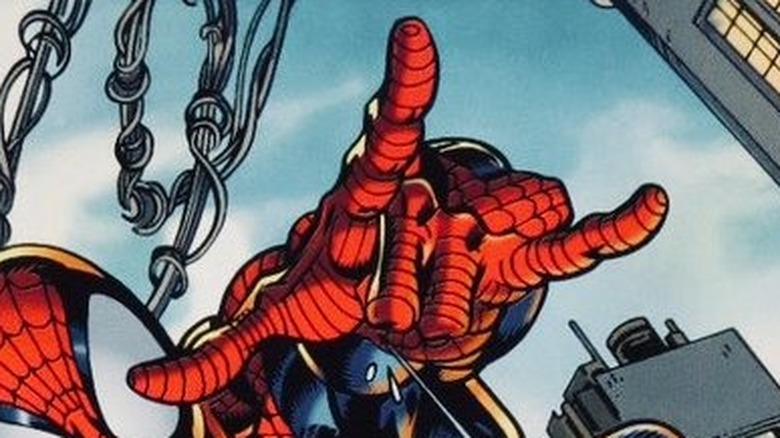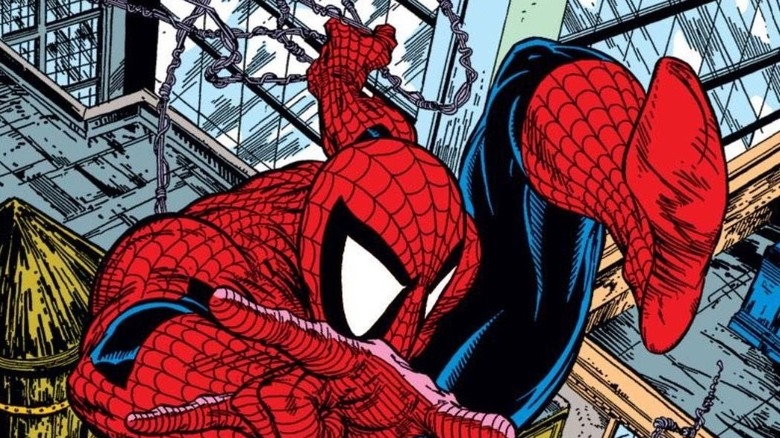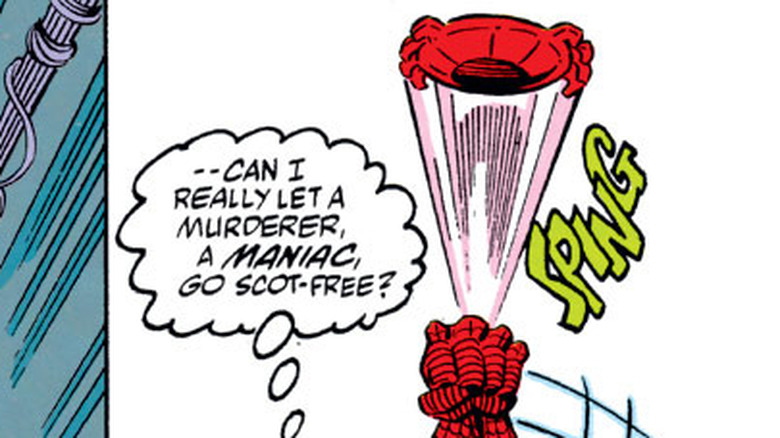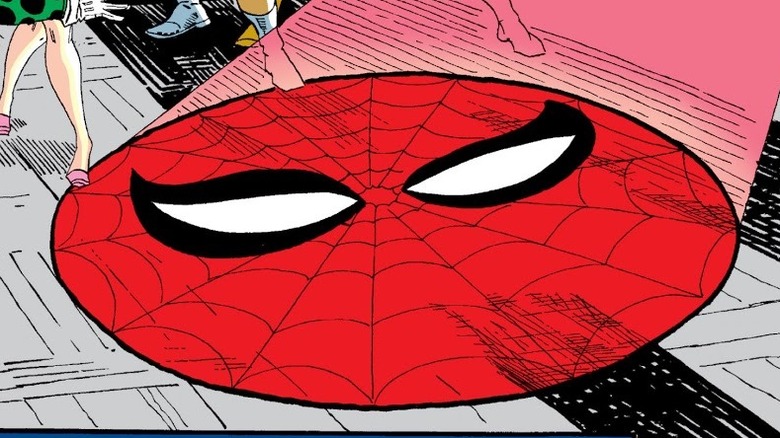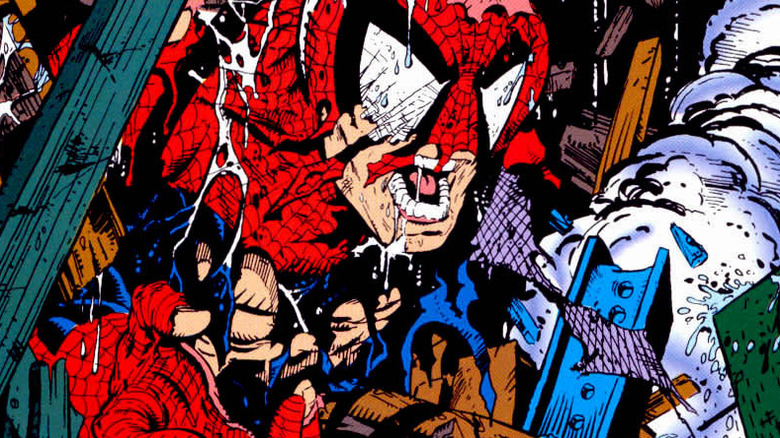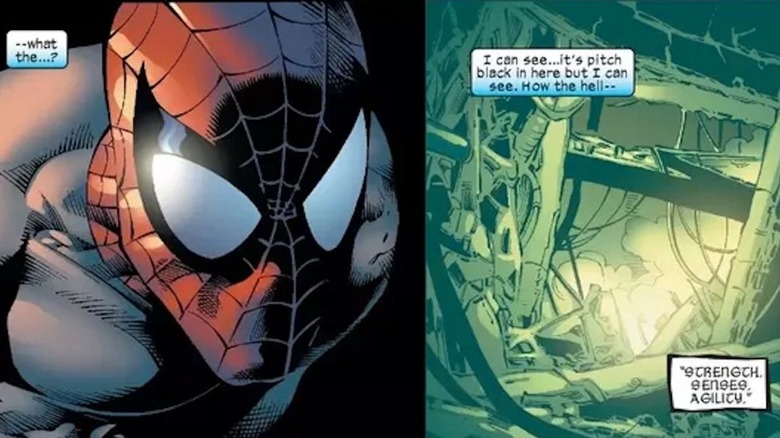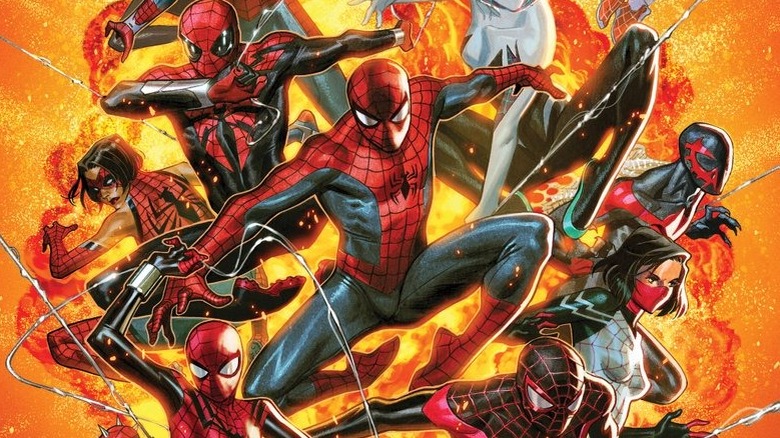All Of Spider-Man's Powers, Explained
Since his debut in 1962, Spider-Man has become a pop culture fixture. He's the star of multiple feature films, numerous animated series, thousands of comic books, and even a Broadway musical. His simple origin story has become as well-known as that of Superman, despite his relative newness: While watching a science demonstration, an irradiated (or in certain interpretations, genetically altered) spider bites high school student Peter Parker, granting him amazing abilities. But when a decision not to act leads to personal tragedy, Peter quickly learns that with great power, there must also come great responsibility.
A major part of Spider-Man's enduring appeal is his everyman quality. Despite his superheroic identity, he still has to worry about bills, school, his love life, and other relatable problems. This normalcy makes it all the more thrilling to see him use his spectacular spider powers to defeat supervillains and save the day. As his famous theme song says, he can do "whatever a spider can" — and we're here to take a detailed look at what that means. These are Spider-Man's powers, including the ones he rarely uses, explained.
Super-strength
In his very first appearance in 1962's "Amazing Fantasy" #15, Peter accidentally crumples a steel pipe in his hands as easily as if it were paper. His newly granted super-strength comes in handy when he decides to take on Crusher Hogan in a wrestling match to earn some money. In the ring, Peter is shown making short work of his massive opponent, lifting and incapacitating a man who is easily twice his size and weight.
Perhaps the most iconic and memorable display of Spider-Man's strength takes place in the pages of 1965's "Amazing Spider-Man" #33. In this issue, Spider-Man finds himself trapped under a ton of machinery, with the medicine he needs to save his Aunt May's life just out of reach. On the verge of giving up, Peter finds strength in the memory of his Uncle Ben. He proceeds to lift the debris and escape with the item.
During Spider-Man's early career, Marvel officially classified him as a "super-mediumweight," putting him in the same strength tier as the metallic mutant Colossus, the cosmic-powered Silver Surfer, and the nigh-invulnerable Luke Cage. However, following his metamorphosis into a man-spider hybrid during the events of "Avengers Disassembled" and his death and rebirth in "The Other: Evolve or Die," Spider-Man got a strength boost. He can now lift "20 tons under optimal conditions," per the "Spider-Man: Back in Black Handbook."
Enhanced speed and agility
To the average New Yorker living in the Marvel universe, it's not unusual to witness a lean, acrobatic figure performing feats of superhuman agility from street lamps, traffic lights, and rooftops. Still, such a sight probably wouldn't grow old, no matter how many times one sees it.
While other street-level superheroes like Daredevil are certainly limber in their own right, it's a safe bet that Spider-Man outclasses pretty much all of them. After all, the web-slinger is estimated to be 15 times more agile than an average human being (per the "Official Handbook of the Marvel Universe: Spider-Man 2005"). Spider-Man has been seen escaping impossibly difficult predicaments innumerable times because of his extraordinary ability to twist, turn, and contort his body. According to the "Spider-Man: Back in Black Handbook," the secret to his spectacular agility is the fact that the tendons and connective tissue in his body are two times as elastic as a regular person's. This ability doesn't work against his super-strength, meaning Spider-Man's body defies both the rules of human anatomy and the laws of physics.
Spider-Man is also one of the Marvel universe's quickest non-speedster heroes. While he can't quite run like Quicksilver, he can definitely outrun someone like Usain Bolt. Amusingly, this is an ability that's easy to overlook, simply because Spider-Man doesn't really have to do much running.
Spider-sense
"Amazing Spider-Man" #1 gave readers their first-ever glimpse of Peter's spider-sense, an iconic ability that became so popular, it's a pop culture trope in itself. Of course, it's worth noting that spiders can't really do this. As the National Wildlife Federation cheekily puts it, "Spiders can detect danger coming their way with an early-warning system called eyes."
Typically depicted as a low-level psychic ability, Spider-Man's spider-sense manifests as a tingling sensation, warning him of impending danger. This amazing ability has saved Spider-Man's hide more times than anyone can count. Spider-sense is a major component of his combat style according to the "Spider-Man: Back in Black Handbook," allowing him to become almost impossible to hit when it is used in conjunction with his superhuman agility and reflexes. While Spidey's spider-sense isn't precise enough to pinpoint the exact source of danger 100% of the time, it can help him anticipate threats that are seconds or even minutes away. Moreover, Spider-Man can gauge the severity of the threat by the intensity of the tingling sensation. This works fabulously with his custom-built tracking devices, which also make him the worst possible person to play hide-and-seek with.
Enhanced reflexes
Peter Parker's spider-sense is certainly remarkable, but it's only one part of the equation when it comes to his ability to avoid incoming danger. His enhanced reflexes make him almost unbeatable in combat, and act as a key component of his early-warning system. Thanks to his body's quick responses, Spider-Man can dodge threats without even seeing them, like a punch from behind or a projectile thrown from a direction not within his direct line of sight.
Over the course of Spider-Man's growth as a superhero, his reflexes, like his other abilities, have gotten a significant boost. According to the "Spider-Man: Back in Black Handbook," Peter now responds to threats faster than an ordinary human being by about 18 times, and can even evade gunfire (provided that the source is a sufficient distance away from him).
Spider-Man's superhuman reflexes also come in handy for non-combat purposes. For instance, in the first Sam Raimi "Spider-Man" movie, Peter (Tobey Maguire) catches Mary Jane Watson (Kirsten Dunst) and her cafeteria tray after she slips. Amazingly enough this scene was created without CGI, meaning the "Spider-Man" production team proved this feat is possible in real life — albeit with a lot of preparation and a ton of takes.
Increased durability and endurance
If you're a superhero, it's a given that you'll find yourself in harm's way on a regular basis. And if you're a street-level superhero in the Marvel universe — a place populated by megalomaniacs with cosmic powers and literal gods — there's a good chance that a well-timed punch from your opponent could make your next adventure your last. Thus, for a superhero like Spider-Man who often finds himself in sticky situations involving far more powerful opponents, the ability to survive seriously strong blows is a godsend.
As the "Official Handbook of the Marvel Universe: Spider-Man 2004" explains, Spider-Man's skeleton and muscles have been greatly enhanced. This allows him to withstand attacks that would scramble a non-super-powered person like an egg. In 1964's "Amazing Spider-Man" #14, for instance, Spider-Man's tussle with the Green Goblin leads to an unexpected confrontation with the Hulk. While he does manage to narrowly dodge a punch from the Hulk, Spider-Man describes the sheer force it generates as "the hardest punch [he] ever felt." "Amazing Spider-Man" #33 offers another example: In that issue, a tired Spider-Man ironically takes a breather by getting beaten up by Doc Ock's goons, giving him time to recover (while taking punches) and fight anew.
Spider-Man also possesses extraordinary endurance, allowing him to surpass the limits of human exhaustion. In recent years, Spider-Man's endurance has increased to the point where he can "fight for hours without rest," according to the "Spider-Man: Back in Black Handbook."
Wall-crawling
Another signature Spider-Man power — the one that earned him the moniker "wall-crawler" — is his ability to cling to various surfaces, even those that are perpendicular to the ground, and traverse them with minimal effort.
According to the "Official Handbook of the Marvel Universe: Spider-Man 2004," Spider-Man's wall-crawling ability (sometimes referred to as "biomagnetism") is possible because of the superhero's mental control over "the inter-atomic attraction between molecular boundary layers." This is essentially a fancy way of saying that he can attach himself to surfaces at will. The upper limit of his ability to stick to surfaces is estimated to be at around several tons per finger. Other individuals who have taken on the mantle of Spider-Man have demonstrated a similar ability, albeit through different methods. Spider-Man 2099, for example, is able to climb walls because of sharp talons on his fingers and toes that retract when they come in contact with his own skin.
For the longest time, this unique trait seemed to be limited to Spider-Man's hands and feet (per the "Spider-Man: Back in Black Handbook"). Over time, however, it has extended to the rest of his body. By this point, he can attach objects and even people to his back — he rescues someone from a collapsed apartment building in this manner in "Amazing Spider-Man" #528.
Webbing (mechanical and organic)
Depending on the incarnation, Spider-Man's webbing may be mechanical or organic in nature. Nevertheless, Peter's ability to "spin a web, any size" has become permanently associated with the character.
In "Amazing Fantasy" #15, Peter is shown creating his web-shooters himself. Utilizing a special nylon-related adhesive formula of his own invention, the teen is able to expel web-like fluid from his wrist-mounted devices via a 65-pound-pressure tap of a button on his palm, using his middle fingers. Per the "Official Handbook of the Marvel Universe: Spider-Man 2004," Peter's synthetic webs have a tensile strength of approximately 120 pounds per square millimeter, and are stored in cartridges that are pressurized to 300 pounds per square inch. They dissolve into powder after two hours.
Following the popularity of the Sam Raimi "Spider-Man" movies, the comics adopted the "organic webs" angle, beginning in 2004's "Spectacular Spider-Man" #20. Returning to his human form after transforming into a human-spider hybrid, Peter discovers he can create organic webbing from his wrists, "limited by his body's health and nutrition" (per the "Official Handbook of the Marvel Universe: Spider-Man 2005"). These new organic webs are as strong as his artificial ones. Modern comics have since disregarded this power, however, and Peter is back to his mechanical web-shooters.
Web-swinging
Spider-Man's webs enable him to pull off odd and exciting feats, from shooting web-balls at opponents to detecting vibrations from his web lines. By far, though, the most beloved, practical, and arguably exciting way Spider-Man uses his webs is to travel around the city, swinging from building to building with relative ease.
When Spider-Man releases webbing from his wrist shooters, they can travel up to approximately 60 feet (more if they're expelled in a ballistic parabolic arc). This allows him to simply leap into the air, sling a web, and perform gravity-defying feats of web-swinging. With this ability, Spider-Man doesn't need vehicles to get around, and can respond to emergency calls very quickly. He can even hitch a ride on moving aircraft in this manner.
In case you were curious about how web-swinging would work in real life, the team that worked on 2012's "The Amazing Spider-Man" has answers for you. In an interview with Popular Mechanics, stunt coordinator Andy Armstrong revealed that they studied slowed-down footage of a gymnast performing acrobatics on high bars to understand Spidey's web-swinging. "In reality, the gymnast is driving himself down with his feet and he pulls this enormous force at the bottom of the arc," Armstrong said. "Then he slows until, at the top of the swing, he's absolutely weightless. And then he starts the next swing." Armstrong's team built a rig that actor Andrew Garfield used to "swing" like Spider-Man at an estimated speed of 40 mph.
Spider-tracers
If Peter's mechanical web-shooters and web fluid formula still aren't enough to have you in awe of his brilliance as an inventor, then perhaps his use of spider-sense as a built-in GPS is. In 1964's "Amazing Spider-Man" #11, Peter uses his self-designed "spider-tracer" for the very first time. A tiny device that typically comes in the shape of his back costume logo, the web-slinging superhero can attach it to any individual or vehicle, which allows him to track them within a certain range. Initially, Peter has to use a spider-tracer-tracker to get readings from the gadget up to 20 miles away. Over time, however, Peter discovers he can attune the tracer's signal to his spider-sense, although the range is much shorter (about 100 yards, as confirmed by Spider-Man himself in "Marvel Knights: Spider-Man" #15). Ben Reilly, Spider-Man's clone, shares this ability as well.
All that said, Spider-Man's tracers do have a significant flaw: Once the person being tracked notices the tracker, they can turn the tables on Spider-Man and lure him into a trap. Symbiotes like Venom can also easily detect (and get rid of) spider-tracers. In an attempt to combat this, newer versions of the spider-tracers are equipped with listening and camouflage capabilities, with some even designed to neutralize specific enemies.
Spider-signal
Just as DC Comics' Gotham City has a Bat-Signal that Commissioner Gordon uses to summon Batman, the Marvel universe has a similar device for Spider-Man — although it doesn't start out that way. In "Amazing Spider-Man" #3, Spider-Man apprehends a group of criminals by shocking them with a high-powered spotlight that resembles his mask. The Spider-Signal is effectively Spider-Man's flashlight, integrated into his belt buckle to help him navigate low-light areas and scare his enemies into surrendering (which typically works on small-time crooks). Per the "Official Handbook of the Marvel Universe: Spider-Man 2004," the rest of Spider-Man's belt holds his web fluid refills, with enough space for 30 cartridges.
The one time that an actual Spider-Signal akin to Gotham's Bat-Signal is built, it doesn't last very long. In "Superior Spider-Man" #3, New York City mayor J. Jonah Jameson proudly unveils the large signal, which is pointed at the night sky. He switches it on in an attempt to summon Spider-Man, but unfortunately, the Spider-Man who shows up is secretly Doc Ock in control of Spider-Man's body — and he's a man with limited patience for such frivolities. The self-christened "Superior Spider-Man" promptly deactivates the signal, and later destroys it completely in a violent battle against the Vulture.
Healing factor
While there's no doubt that Spider-Man is an amazing hero, he certainly isn't the strongest or hardiest one around. In fact, it's quite common for him to sustain all sorts of injuries after every battle, whether it's a cut from one of the Green Goblin's razorbats, burns from Electro's electric blasts, or flesh wounds from gunshots he narrowly dodged. Fortunately, the web-slinger can heal from injuries faster than the average person.
According to the "Spider-Man: Back in Black Handbook," Spider-Man has a "superhuman metabolism" that allows him to bounce back from nearly any beating. Unfortunately, this doesn't mean that he's immune to illnesses. As countless issues of the comics have shown, a simple bout of the flu or a nasty cold can render Spider-Man powerless and bedridden until he fully recovers.
Additionally, his healing factor isn't as powerful as Wolverine or Deadpool's regenerative powers. When the dimension-hopping life force vampire Morlun rips out Spider-Man's left eye in "Amazing Spider-Man" #526, it doesn't grow back. Thankfully, a few issues later, Spider-Man emerges from his "rebirth cocoon" with all his body parts intact.
Night vision
For most of his costumed career, Spider-Man has been able to see in the dark just about as well as most other heroes can. This never really bothers the wall-crawler much, as he learns to use his spider-sense to guide him through total darkness. While obviously not as good as Daredevil's radar sense, it certainly works in a pinch. This is why his discovery of a new ability in "Amazing Spider-Man" #528 comes as a complete shock to him.
Peter emerges from his cocoon, following his death at the hands of Morlun. While he's still getting used to being back in the land of the living, a news report about a collapsed apartment building jolts him into action. Arriving at the scene, Spider-Man responds without hesitation, attempting to save as many lives from the wreckage as possible. However, when he ventures deeper into the ruins, he is surprised to discover that he can see in the dark, just as if he were wearing a pair of night-vision goggles.
One would think that such an ability would see increased use in the comics. Curiously, Spider-Man's night vision capabilities are rarely brought up and sometimes even ignored, just like many of the other upgrades he received before the "Brand New Day" storyline revamped the status quo.
Stingers
Despite the tremendous power at his disposal, Spider-Man isn't known for using brutal attacks or offensive weapons. In fact, he often practices immense self-restraint so as not to permanently injure or incapacitate his opponents. Doc Ock learns this fact firsthand in "Amazing Spider-Man" #700 when, while controlling Spider-Man's body, he accidentally knocks the Scorpion's jaw right off his face with a single punch. Perhaps that's why it feels so odd and out of place when Spider-Man (temporarily) has the ability to release stingers from his wrists.
First seen in his fatal struggle against Morlun in "Friendly Neighborhood Spider-Man" #3, Spider-Man has, for a limited time, a stinger housed in each arm. He ejects the stingers from his wrists after being subjected to intense stress, or when facing off against mystical opponents. Aside from being sharp tools for impaling his foes, Spider-Man's stingers also contain a polyamine venom that can paralyze an ordinary human being for hours and outright kill mystical beings like Morlun (per the "Spider-Man: Back in Black Handbook").
Spider-Man no longer possesses this strange power. However, his genetic duplicate Kaine gains the ability, alongside other power upgrades, when he embraces the spider-deity known as the Other.
Connection to the Web of Life and Destiny
When the mysterious Spider-person known as Ezekiel Sims enters Spider-Man's life in "Amazing Spider-Man" #30, he introduces a new idea: The circumstances that gave Peter Parker his powers may not have been solely scientific in nature. In later appearances, Ezekiel tells Peter about the Great Web, a metaphysical construct spun by mystical forces eons ago. This idea is further developed in later comics, especially the massive "Spider-Verse" storyline, which reveals the Web to be the source from which Spider-Man and his multiversal counterparts derive their unique abilities, particularly their spider-sense.
The Web of Life and Destiny serves as a multi-pronged "bridge" that connects all realities across the Marvel multiverse. Guarded by the Great Weaver, the Web enables Spider-people from different realities to travel to different Earths by means of a Dimensional Travel Watch. Spider-Man and his counterparts first use this to stop Morlun and his family of Inheritors from consuming the life forces of all Spider-people across the multiverse.
While the Web itself hardly plays a role in Spider-Man's everyday adventures, it does get brought up fairly frequently, especially when the hero has to deal with interdimensional threats that require the assistance of other Spider-types.
